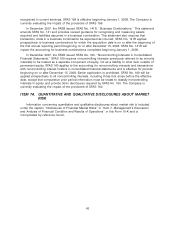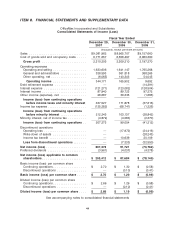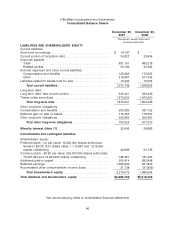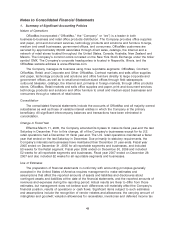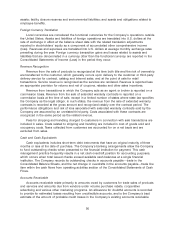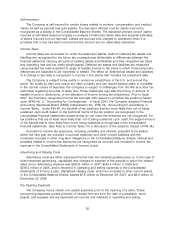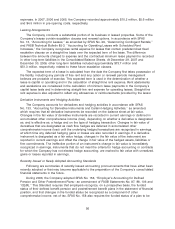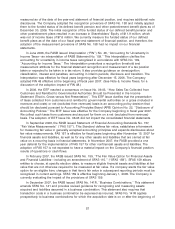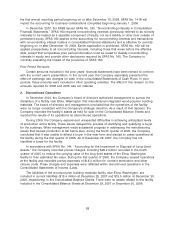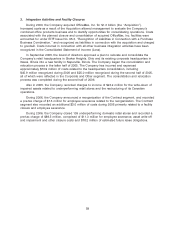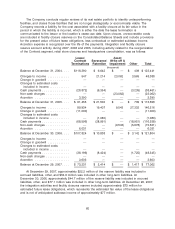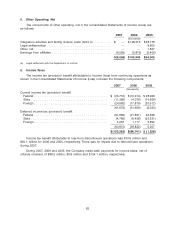OfficeMax 2007 Annual Report Download - page 57
Download and view the complete annual report
Please find page 57 of the 2007 OfficeMax annual report below. You can navigate through the pages in the report by either clicking on the pages listed below, or by using the keyword search tool below to find specific information within the annual report.December 30, 2006, the Company held an investment in Boise Cascade, L.L.C., which is accounted
for under the cost method. Investments that enable the Company to exercise significant influence
over an affiliated company, but do not represent a controlling interest, are accounted for under the
equity method; such investments are carried at cost and are adjusted to reflect the Company’s
proportionate share of income or loss, less dividends received. The Company periodically reviews
the recoverability of investments in affiliates. The Company would recognize a loss on these
investments if there is a loss in value of an investment which is other than a temporary decline.
(See Note 9, Investments in Affiliates, for additional information related to the Company’s
investments in affiliates.)
Capitalized Software Costs
The Company capitalizes certain costs related to the acquisition and development of internal
use software that is expected to benefit future periods in accordance with American Institute of
Certified Public Accountants’ Statement of Position (‘‘SOP’’) 98-1, ‘‘Accounting for the Costs of
Computer Software Developed or Obtained for Internal Use.’’ These costs are amortized using the
straight-line method over the expected life of the software, which is typically three to five years.
Deferred charges in the Consolidated Balance Sheets include unamortized capitalized software
costs of $45.6 million and $25.7 million at December 29, 2007 and December 30, 2006,
respectively. Amortization of capitalized software costs totaled $15.2 million, $17.7 million and
$25.6 million in 2007, 2006 and 2005, respectively.
Software development costs that do not meet the criteria for capitalization are expensed as
incurred.
Pension and Post Retirement Benefits
The Company sponsors noncontributory defined benefit pension plans covering certain
terminated employees, vested employees, retirees, and some active OfficeMax, Contract
employees. The Company also sponsors various retiree medical benefit plans. The type of retiree
medical benefits and the extent of coverage vary based on employee classification, date of
retirement, location, and other factors. The Company explicitly reserves the right to amend or
terminate its retiree medical plans at any time, subject only to constraints, if any, imposed by the
terms of collective bargaining agreements. Amendment or termination may significantly affect the
amount of expense incurred.
As of December 30, 2006, the Company adopted SFAS 158, ‘‘Employers’ Accounting for
Defined Benefit Pension and Other Postretirement Plans—an amendment of FASB Statements
No. 87, 88, 106, and 132(R).’’ SFAS 158 requires employers to fully recognize the funded status of
single-employer defined benefit pension, retiree healthcare and other postretirement plans in the
Consolidated Balance Sheets, with changes in the funded status recognized through other
comprehensive income, net of tax, in the year in which the changes occur. Actuarially-determined
liabilities related to pension and postretirement benefits are recorded based on estimates and
assumptions. Key factors used in developing estimates of these liabilities include assumptions
related to discount rates, rates of return on investments, future compensation costs, healthcare cost
trends, benefit payment patterns and other factors.
The Company measures changes in the funded status of its plans using actuarial models in
accordance with SFAS 87, ‘‘Employers’ Accounting for Pension Plans,’’ and SFAS 106, ‘‘Employers’
Accounting for Postretirement Benefits Other Than Pensions.’’ These models use an attribution
approach that generally spreads recognition of the effects of individual events over the estimated
service lives of the employees in the plan. The attribution approach assumes that employees render
service over their service lives on a relatively smooth basis and as such, presumes that the income
statement effects of pension or postretirement benefit plans should follow the same pattern. Net
53


